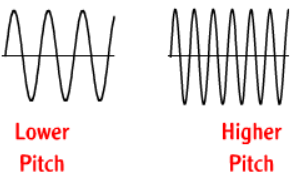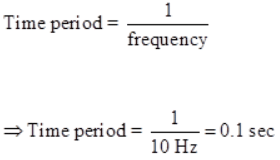Lakhmir Singh & Manjit Kaur: Sound- 2 | Lakhmir Singh & Manjit Kaur Solutions: Class 8 Science PDF Download
Q.36. What is the loudness of a normal conversation in decibels?
The Normal conversation is at 60 dB
Q.37. On what factor does the pitch of a sound depend?
The pitch of a sound depends on the frequency of the sound.
Q.38. How is pitch related to frequency?
The pitch of a sound you hear depends on the frequency of the sound wave. A high-frequency sound wave has a high pitch, and a low-frequency sound wave has a low pitch.
Q.39. Name the characteristic of sound which enables us to distinguish between a man’s voice and a woman’s voice even without seeing them.
The pitch of the sound enables us to distinguish between a man’s voice and a woman’s voice even without seeing them.
Q.40. Arrange the following sounds in the order of increasing frequencies (keeping the sound of lowest frequency first) :
(i) Baby’s voice
(ii) Man’s voice
(iii) Woman’s voice
The following sounds in the order of increasing frequencies :
- Man’s voice
- Woman’s voice
- Baby’s voice
Q.41. Which produces sound of a higher pitch : a drum or a whistle?
Drum produces higher pitch.
Q.42. Name the characteristic of sound which depends on:
(a) amplitude
(b) frequency.
(a) Loudness of the sound depends on amplitude.
(b) Pitch of the sound depends on frequency.
Q.43. Name the characteristic of sound which can distinguish between the ‘notes’ (musical sounds) played on a flute and a sitar (both the notes having the same pitch and loudness).
The tone of the sound will distinguish between the ‘notes’ (musical sounds) played on a flute and a sitar (both the notes having the same pitch and loudness).
Q.44. Write the full form of dB.
Decibels is the full form of dB.
Q.45. What is the name of very high frequency sounds which cannot be heard by the human ear?
Ultrasonic waves are the name of very high frequency sounds which cannot be heard by the human ear.
Q.46. Why do we not hear the screams of a bat?
We cannot hear the screams of a bat because its frequency is higher than 20,000Hz.
Q.47. Which of the following frequency of sound can be heard by a dog but not by a man?
(a) 50,000 hertz
(b) 15,000 hertz.
50,000Hz can be heard by dog but not human being.
Q.48. Name the substance which vibrates in a flute to produce sound.
The air particles vibrate in the air column in the flute, which produces sound.
Q.49. State whether the following statements are true or false:
(a) Sound cannot travel in vacuum.
(b) The number of oscillations per second of a vibrating object is called its time-period.
(c) If the amplitude of vibrations is large, sound is feeble.
(d) The lower the frequency of vibration, the higher is the pitch.
(e) If the amplitude of vibrations is doubled, the loudness of sound also gets doubled.
(f) When the amplitude of vibrations is halved, the loudness of sound becomes one-fourth.
(g) Unwanted or unpleasant sound is termed as music.
(h) Noise pollution may cause partial hearing impairment.
(a) True
(b) False
(c) False
(d) False
(e) True
(f) False
(g) False
(h) True
Q.50. Fill in the following blanks with suitable words :
(a) Sounds are produced by ______ objects.
(b) The human voice box is called ______
(c) Sound cannot travel in ______
(d) A set of three tiny ______ in the middle part of ear passes on sound vibrations from the eardrum to the liquid in the cochlea.
(e) The unit of frequency is ______
(f) The time taken by an object to complete one oscillation is called ______
(g) The shrillness of a sound is determined by the ______ of vibration.
(h) Unpleasant sound is called ______
(i) Sound which is pleasing to the ear is called ______ sound.
(j) A person having partial hearing loss can hear properly by wearing a device called hearing ______ on the ear.
(a) Sounds are produced by vibrating objects.
(b) The human voice box is called larynx
(c) Sound cannot travel in vacuum
(d) A set of three tiny bones in the middle part of ear passes on sound vibrations from the eardrum to the liquid in cochlea.
(e) The unit of frequency is Hertz (Hz)
(f) The time taken by an object to complete one oscillation is called time-period
(g) The shrillness of a sound is determined by the frequency of vibration.
(h) Unpleasant sound is called noise.
(i) Sound which is pleasing to the ear is called musical sound.
(j) A person having partial hearing loss can hear properly by wearing a device called hearing machine on the ear.
Short Answer Type Questions
Q.51.
(A) What is the name of the strings in the human voice box which vibrate to produce sound?
The vocal chords of the human voice box vibrate to produce sound.
(B) What makes these strings vibrate?
The vocal chords are stretched across the larynx and they vibrate to produce sound.
Q.52. Describe how sound is produced by the human voice box (or larynx).
In humans, the sound is produced by the box, which is called voice box or the larynx. Larynx is a part of the throat. It is responsible for production of sound. It has two vocal cord which are stretched across the voice box or larynx in such a way that it leaves a narrow slit between them for the air. When the lungs force the air through the slit, the vocal cords vibrate, producing sound.
Q.53. What is the frequency of the sound produced when the vocal cords are:
(a) tight and thin?
(b) loose and thick?
(a) The frequency produced by tight and thin vocal chords is quite high. i.e. its high pitch sound.
(b) The frequency produced by loose and thick vocal chords is quite low i.e. its low pitch sound.
Q.54. Why are the voices of men, women and children different?
The length of vocal chords varies in all these three, which is the main reason for different voices. Men have the longest vocal chords, while female have little shorter vocal chords than men and children have the smallest vocal chords.
Q.55. If you want to hear a train approaching from far away, why is it more convenient to put the ear to the track?
It is more convenient to put the ear to the track, If you want to hear a train approaching from far away because we can hear the vibrations from the ground when we put our ear at the track.
Q.56. State one observation from everyday life which shows that sound travels much more slower than light.
In case of thunder, we see the lightening first and then the sound of thunder. This is because, the velocity of light in air is while the velocity of sound in air is 343 m/s.
Q.57. Explain why, the flash of lightning is seen first but the sound of thunder is heard a little later (though lightning and thunder take place in the sky at the same time and same distance from us).
The flash of lightning is seen first but the sound of thunder is heard a little later though lightning and thunder take place in the sky at the same time and same distance from us, because, the velocity of light in air is while the velocity of sound in air is 343 m/s. Thus, we can see light first and thunder sound later.
Q.58. Name the object (or part) which vibrates to produce sound in the following musical instruments:
(a) Sitar
(b) Dholak
(c) Flute
(d) Cymbals
(e) Veena
(f) Tabla
(a) Strings
(b) Diaphragm – Membrane
(c) Air column
(d) The metal plates
(e) Strings
(f) Diaphragm – Membrane
Q.59. Name one musical instrument each in which the sound is produced:
(a) by vibrating a stretched string.
(b) by vibrating air enclosed in a tube.
(c) by vibrating a stretched membrane
(d) by vibrating metal plates.
(a) Veena
(b) Flute
(c) Table
(d) Cymbals
Q.60. Give two examples of each of the following :
(a) stringed musical instruments.
(b) wind musical instruments.
(c) membrane musical instruments.
(d) plate type musical instruments.
(a) Guitar, Veena
(b) Flute, Trumpet
(c) Tabla, Dholak
(d) Cymbals, Matka
Q.61. Which of the sounds having the following frequencies can be heard by the human beings and which cannot?
(a) 6 hertz
(b) 5000 hertz
(c) 10000 hertz
(d) 35000 hertz
(e) 18kHz
(a) Cannot be heard because human being can hear within the range 20Hz to 20,000Hz
(b) Can be heard because human being can hear within the range 20Hz to 20,000Hz
(c) Can be heard because human being can hear within the range 20Hz to 20,000Hz
(d) Cannot be heard because human being can hear within the range 20Hz to 20,000Hz
(e) Can be heard because human being can hear within the range 20Hz to 20,000Hz
Q.62.
(A) What is the upper limit of frequency of human hearing?
20,000Hz is the upper limit of frequency of human hearing.
(B) What is the lower limit of frequency of human hearing?
20Hz is the lower limit of frequency of human hearing.
(C) Name one animal which can produce ultrasonic sounds.
Bats can produce ultrasonic sounds.
(D) Name two animals which can hear ultrasonic sounds.
Dogs and cats.
Q.63.
(A) What is a vibration (or an oscillation)? Define ‘amplitude’ of vibration of an object.
The to- and – fro motion of an object in a medium is called vibration.
Amplitude is the largest distance from the mean position of the object.
(B) What is the frequency of a vibrating body whose time-period is 0.05 second?
Time Period has given by the inverse of the frequency.
Q.64.
(A) State two methods of producing sound.
Two methods of producing sound are:
Beating the plate and spoon against each other.
Playing guitar.
(B) How does sound from a sound producing body travel through air to reach our ears?
The air particles near the sound producing body vibrate and exchange energy, which is received by our ears and we are able to hear the sounds.
Q.65.
(A) Why a sound cannot be heard on the moon?
Because moon does not have any atmosphere and sound its does not have any medium for sound to travel as sound does not travel in vacuum.
(B) How do astronauts talk to one another on the surface of moon and why?
The astronauts have sound transmitting devices in the helmets they wear which help them exchange sound waves with one-another. This is because moon does not have any atmosphere and sound its does not have any medium for sound to travel as sound does not travel in vacuum.
Q.66
(A) What is meant by the (a) ‘pitch’ of sound, and (b) ‘quality’ of sound?
The sensation of frequency is called “pitch” The high frequency indicates high pitch and vice-versa.
(B) What is ultrasound? State two uses of ultrasound.
Ultrasounds mean the sounds having a frequency greater than 20,000Hz.
The uses of ultrasound are:
- They are used in sonography.
- They used in radars.
Q.67
(A) What differences will you hear in a sound if there is an increase in
(i) amplitude, and
(ii) frequency?
(i) The sound will become loud on increasing the amplitude.
(ii) The sound will become shrill on increasing the frequency.
(B) Calculate the time period of a pendulum which is vibrating with a frequency of 10 hertz.
Time Period given by the inverse of the frequency.
Q.68
(A) How can you show that a sounding tabla is vibrating?
We can feel the vibration of table membrane when we hit it to produce sound.
(B) On what factor does the loudness of a sound depend?
The loudness of a sound depends Amplitude.
Q.69. When we put our ear to a railway line, we can hear the sound of an approaching train even when the train is far off but its sound cannot be heard through the air. Why?
Because the track is made of metals and sounds travel faster in solids than air. Thus, we can hear the sound of an approaching train even when the train is far off but its sound cannot be heard through the air.
Q.70. Why sound cannot travel through vacuum (or through outer space)?
Because sound needs material medium to transfer energy from on particle to another particle. If there is vacuum, then no energy transfer takes place.

























